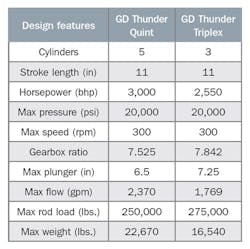From rig count to head count, the economic downturn of the last few years has been rough on the oil and gas industry. During that time, operators, upstream equipment contractors and everyone in between had to determine how to make more or do more with less. Compounding this problem was the uncertain political outcome that put any sort of market rebound “in the air” and companies with massive credit lines suddenly at risk of bankruptcy or being acquired.
Although exploration and production (E&P) companies took measures to reduce costs and delay any capital expenditures to remain competitive in the market throughout 2015 and 2016, tightened budgets and bootstrapped strategies have had significant impacts on the equipment in the industry.
How did we get here?
Prior to 2015, as the hydraulic fracturing industry grew, so did the demands and expectations placed on well-servicing pump units. With wells being drilled deeper and with higher pressures and more challenges, the greater the power requirements became on hydraulic fracturing pumps. When the market dropped, E&P companies were forced to scale back their equipment maintenance programs, placing their drilling and upstream equipment in vulnerable positions.
Many operators and oil field equipment providers depend on aggressive schedules, or preventative maintenance programs, to keep equipment functioning and operations moving forward. With less capital, however, these maintenance programs have been tightened or altogether abandoned in favor of reactive, or run-to-failure, maintenance programs that require much less upfront investment. Companies began pushing equipment to max capacity to do more with less. In many instances, maintenance managers or field personnel mixed and matched pumps and fluid ends to make quick repairs and push equipment further, which only complicated the matter and resulted in bigger problems down the road.
With experts forecasting a busy 2017 for the oil and gas industry, operators are now looking to upgrade equipment.
Well-servicing
The average hydraulic fracturing pump can run 5,000 hours before a major overhaul with a standard maintenance plan. However, most modern fracking sites run 24-hour operating schedules with less time between stages and minimal preventive maintenance. This results in accumulating pumping hours much sooner along with higher spending on repairs within those 5,000 hours. With 2017 signaling an uptick in drilling and production, operators and drilling contractors are looking to upgrade equipment, a move that is long overdue. Hoping to capitalize on the innovation that has taken place in the industry over the last few years, E&P companies want to upgrade to a more efficient fracturing pump with a longer operating life. Now more than ever, operators need equipment to run efficiently with greater capacity and improved serviceability at a cost-competitive rate.
Adapting for a new age in E&P
When equipment is put to the ultimate test, as during market downturns, manufacturers gain invaluable information they can use to develop new, innovative equipment. The latest downturn prompted well-established pump manufacturers to use what they learned during the downturn to develop new, tough pumps that work more efficiently, last longer, and are easier to maintain.
For example, with 2,550 and 3,000 brake horsepower (bhp) models, a new series of well service pumps is designed to offer operators and well-servicing contractors increased horsepower and rod load with longer life and service intervals that are aligned with those of the engine and transmission. The new lineup includes the longer 11-inch stroke (versus the typical 8-inch) to provide 37 percent more flow per cylinder, per rotation of the pump. This reduces the pump speed required to achieve the same flow and pressure output of conventional shorter-stroke pumps. That means these pumps accumulate fewer cycles over time, which decreases the overall wear and tear. The result is longer time between scheduled maintenance intervals and a reduced rate of consumable part use.
That 37 percent increase in output could also be used at the conventional 8-inch pump speed or more to provide additional flow per frac unit. This would exchange some of the increased consumable life (and cost savings) at slower speeds to increase the total frac-fleet output and potentially reduce the number of frac trailers needed on a particular site. These pumps were also designed with conventional trailers in mind to perform well on retrofitted 2,200 to 2,500 hp trailers as well as newer, higher speed, higher hp drives and trailers.
Table 1. A comparison of two new pumps for oil and gas operations
Modular pump designs that run smooth
Heavy vibrations in the pump wear out components faster and present unnecessary stress on everything connected to it downstream and on the trailer. In some cases, it can cause significant problems with unwanted cost, repair and downtime. The new pumps embody a modular design with a focus on smooth operation, maintenance and serviceability. The crankshafts have been optimized with a specific firing order and added counter weights where necessary to absolutely minimize the vibrations and shaking forces of operation.
The modular design of these pumps is intended to facilitate simple disassembly and quick servicing. Many parts can be easily replaced or flipped over to renew the operation of those components. Large wrenches have also been eliminated while providing enlarged access covers and openings for easier serviceability.
New coatings
The new pump series utilizes proprietary coatings on all critical wear surfaces in the power end. These new coatings, which are applied to all cross-heads, journal bearings and thrust bearings, provide dry film lubrication that reduces scuffing, friction and adhesive wear. They are also designed to increase the load-carrying capacity and reduce the wear of each bearing surface because of the low coefficient of friction. The coatings are also chemical-resistant to provide corrosion protection.
New fluid-end technology with familiar features
The new pump series features a new fluid-end design with long life. High-strength, corrosion-resistant stainless steel and patented twist-in retainer technology come standard. The spring retainer design reduces fluid-end stress and enables rapid valve and packing changes with no alignment or special tools necessary.
Jim Yanus supervises New Product Development & Engineering for Gardner Denver’s Petroleum & Industrial Pumps division. He holds a Bachelor of Science in Mechanical Engineering from the Rochester Institute of Technology. He is based in Tulsa, Oklahoma and may be reached at 918-828-7899 or [email protected]. Gardner Denver has been a manufacturer of petroleum and industrial pumps for more than 150 years. The company offers a full circle of service and support through product training, parts on demand, customer service and repair, from the point of the sale to the end of the pump’s life. Learn more about Gardner Denver PI&P at gardnerdenverpumps.com.





